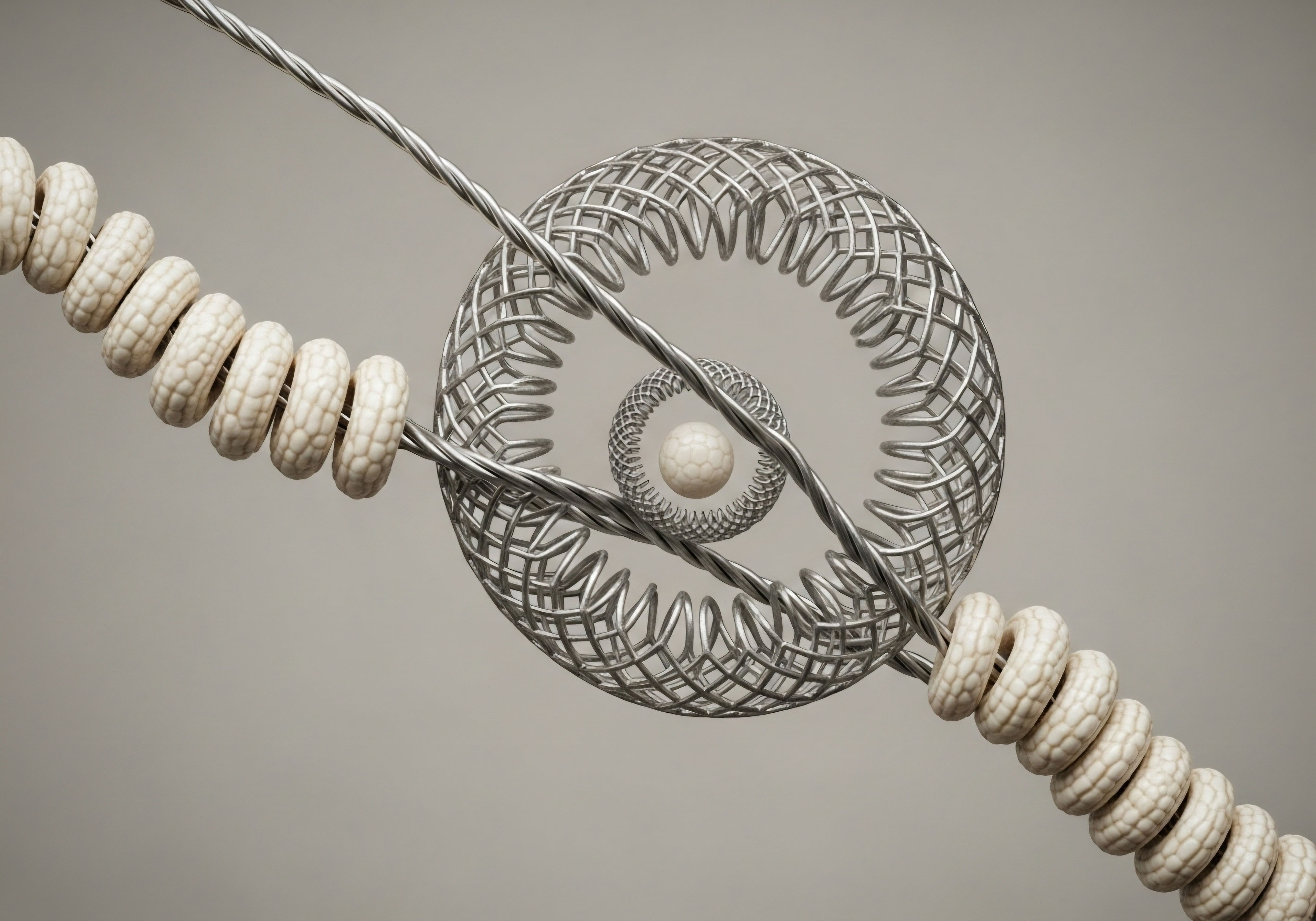

Fundamentals
You feel it in your body. A subtle shift in energy, a change in how you recover from a demanding day, or a difference in your mood and mental clarity. These experiences are real, and they are frequently rooted in the silent, intricate language of your hormones.
Your endocrine system is the body’s internal communication network, a series of glands that produce and secrete hormones, which act as chemical messengers. These messengers travel through your bloodstream to every tissue and organ, carrying instructions that regulate nearly every process in your body, from metabolism and growth to sleep and emotional state. Understanding this system is the first step toward reclaiming control over your biological function and overall vitality.
At the center of this network are two primary command-and-control systems ∞ the Hypothalamic-Pituitary-Adrenal (HPA) axis and the Hypothalamic-Pituitary-Gonadal (HPG) axis. The HPA axis is your body’s primary stress response system. When faced with a stressor, the hypothalamus releases a hormone that signals the pituitary gland, which in turn signals the adrenal glands to release cortisol.
Cortisol is essential for life, helping to manage blood sugar levels, regulate metabolism, and reduce inflammation. The HPG axis governs reproductive function and the production of sex hormones. In men, this axis controls the release of testosterone from the testes. In women, it orchestrates the menstrual cycle and the production of estrogen and progesterone from the ovaries. These two axes are deeply interconnected, and their balance is fundamental to your sense of well-being.

The Key Messengers and Their Roles
Within this complex network, several key hormones are particularly responsive to lifestyle inputs, including physical activity. Their balance dictates much of how you feel and function day to day.

Testosterone a Hormone of Vitality
Testosterone is a primary anabolic hormone, meaning it promotes growth and tissue repair. In men, it is the principal male sex hormone, responsible for maintaining muscle mass, bone density, and strength. It also influences cognitive function, mood, and competitive drive.
Women also produce testosterone, albeit in much smaller amounts, where it plays a similar role in maintaining muscle, bone health, and libido. When testosterone levels are optimized, individuals often report a greater sense of vigor, confidence, and resilience. A decline in this hormone can manifest as fatigue, reduced motivation, and difficulty building or maintaining muscle mass.

Cortisol the Double Edged Sword
Cortisol, often labeled the “stress hormone,” has a more complex role than its reputation suggests. It is released in a natural daily rhythm, peaking in the morning to promote wakefulness and gradually declining throughout the day. In acute situations, cortisol is beneficial, providing the body with a quick burst of energy for the “fight or flight” response.
It mobilizes glucose for immediate use and has potent anti-inflammatory effects. The issues with cortisol arise when its release becomes chronically elevated due to persistent physical or psychological stress. Sustained high levels can lead to muscle breakdown, increased fat storage, immune suppression, and disruption of other hormonal systems, including the HPG axis.

Growth Hormone the Agent of Repair
Growth Hormone (GH) is another powerful anabolic agent, playing a critical part in cellular regeneration and repair. Secreted by the pituitary gland in pulses, primarily during deep sleep and in response to certain stimuli like intense exercise, GH stimulates the liver to produce Insulin-Like Growth Factor 1 (IGF-1).
Together, GH and IGF-1 promote the repair of tissues, including muscle and collagen, support bone density, and influence metabolism by encouraging the use of fat for energy. Its role is central to recovery and the long-term maintenance of a healthy body composition.

Exercise as a Hormonal Conversation
Physical activity is one of the most powerful modulators of this intricate hormonal conversation. Each workout you perform is a stimulus, a piece of information that your body translates into a cascade of chemical signals. The type, intensity, and duration of the exercise you choose dictates the nature of this hormonal response.
A long, slow endurance run sends a very different set of messages to your endocrine system than a short, intense session of heavy weightlifting. By understanding this principle, you can begin to use exercise with intention, selecting protocols that encourage the specific hormonal adaptations you seek for long-term stability and wellness.
Exercise is a direct and potent stimulus that instructs the body’s endocrine system to adapt, influencing long-term hormonal balance.
The body does not view exercise as a simple expenditure of calories. It interprets physical activity as a demand, a challenge to which it must adapt to become more resilient. This adaptation process is mediated almost entirely by hormones.
A resistance training session that challenges your muscles signals a need for repair and growth, prompting an anabolic response characterized by the release of testosterone and growth hormone. Conversely, a prolonged endurance event can be perceived as a significant stressor, leading to a sustained release of cortisol to manage energy demands.
Over time, your body’s hormonal environment adapts to the type of demands you consistently place upon it. The goal of a well-designed exercise protocol is to create a pattern of signaling that promotes a robust, resilient, and balanced endocrine system, capable of supporting vitality for years to come.


Intermediate
Understanding that exercise modulates hormones is the first step. The next is to appreciate how different forms of physical activity create distinct hormonal signatures. The body’s endocrine response is highly specific to the demands imposed upon it. We can categorize these demands broadly into resistance, endurance, and high-intensity interval training.
Each protocol initiates a unique cascade of hormonal events, and consistent engagement with a specific type of training leads to predictable long-term adaptations in your baseline hormonal environment.

Resistance Training the Anabolic Signal
Resistance training, which involves contracting muscles against an external load, is a powerful stimulus for anabolism, the process of building tissue. The primary goal of the hormonal response to this type of exercise is to repair the microscopic damage done to muscle fibers and to rebuild them stronger and larger. This process is orchestrated by key anabolic hormones.

Acute Hormonal Response to Resistance Exercise
During and immediately following a sufficiently intense resistance training session, the body initiates a significant hormonal shift. The key characteristics of a workout that elicits this response are high volume (multiple sets), moderate to high intensity (using challenging weights), and short rest intervals (30-90 seconds), all of which create a substantial metabolic demand.
- Testosterone ∞ In men, this type of training triggers a notable, albeit transient, increase in circulating testosterone levels. This acute elevation is thought to play a role in initiating the muscle protein synthesis cascade by increasing the interaction of testosterone with androgen receptors in muscle cells. The response in women is less pronounced and more variable.
- Growth Hormone (GH) ∞ Resistance exercise is perhaps the most potent non-pharmacological stimulus for GH release. The magnitude of the GH response is directly related to the intensity of the exercise. The buildup of lactate in the muscle during strenuous sets is a key chemical signal that prompts the pituitary gland to secrete GH. This surge in GH, and the subsequent release of IGF-1, is critical for tissue repair and remodeling.
- Cortisol ∞ Strenuous resistance training is also a physical stressor, and as such, it elicits a cortisol response. This release helps to mobilize glucose to fuel the workout and manages inflammation. In the context of an acute workout, this cortisol spike is a normal and necessary part of the adaptive process. The balance between the anabolic signals (testosterone, GH) and the catabolic signal (cortisol) is what determines the net effect of the workout.

Long-Term Adaptations from Resistance Training
Consistent resistance training leads to more than just acute hormonal spikes. Over months and years, the endocrine system adapts to become more efficient at managing the demands of this type of stress. While resting testosterone levels may not show a dramatic increase, the body becomes more sensitive to anabolic signals.
This includes an upregulation of androgen receptor density in muscle tissue, meaning the body can make better use of the testosterone it has. Furthermore, regular resistance training can help mitigate the age-related decline in both testosterone and growth hormone, preserving a more youthful hormonal profile later in life.
Strategic resistance training protocols create a powerful anabolic hormonal environment conducive to muscle repair, growth, and long-term vitality.

Endurance Training the Catabolic Challenge
Endurance or aerobic exercise, characterized by sustained, lower-intensity activity, presents a different set of challenges to the body. The primary demand is not muscular force production but sustained energy delivery over a long duration. This requires a different hormonal strategy, one focused on fuel mobilization and metabolic efficiency.

Acute Hormonal Response to Endurance Exercise
During a prolonged endurance session (e.g. a long run or bike ride), the body’s main priority is to maintain blood glucose levels to fuel the brain and working muscles. This is largely a catabolic process, driven by stress hormones.
- Cortisol ∞ Cortisol is the dominant hormone in the endurance exercise response. It rises significantly to stimulate gluconeogenesis (the creation of glucose from other sources like amino acids) and lipolysis (the breakdown of fat for energy). The longer and more intense the endurance session, the greater and more sustained the cortisol release.
- Testosterone ∞ Unlike resistance training, prolonged endurance exercise is often associated with a decrease in testosterone levels, both during and after the session. This effect is particularly pronounced in exhaustive sessions. The combination of elevated cortisol and suppressed testosterone creates a highly catabolic environment.
- Growth Hormone ∞ GH is also released during endurance exercise, particularly when the intensity surpasses the lactate threshold. However, its anabolic effects may be blunted by the overwhelmingly catabolic environment created by high cortisol levels.

Long-Term Adaptations from Endurance Training
Chronic high-volume endurance training can lead to significant baseline hormonal changes. Elite endurance athletes, for example, often exhibit lower resting testosterone levels compared to their sedentary or resistance-trained counterparts. This is sometimes referred to as “exercise-hypogonadal male condition.” The HPG axis can become suppressed due to the combined stress of high training volume and, in some cases, insufficient energy intake.
While the body becomes incredibly efficient at fat metabolism and cardiovascular function, the hormonal cost can be substantial if not managed properly with adequate nutrition and recovery. The key is to balance training volume with recovery to prevent chronic suppression of the HPG axis.

Comparing Exercise Modalities
The distinct hormonal responses to different training styles are summarized below. These represent the general patterns observed in clinical research.
| Hormone | Resistance Training (Acute) | Endurance Training (Acute) | Long-Term Adaptation (Consistent Training) |
|---|---|---|---|
| Testosterone | Significant increase (especially in men) | Decrease or no change | May help preserve levels with age (Resistance); Can decrease resting levels (High-Volume Endurance) |
| Growth Hormone | Large, robust increase | Moderate increase (intensity-dependent) | May increase 24-hour secretion and sensitivity |
| Cortisol | Moderate to high increase | Significant, sustained increase | Improved stress response; blunted response to a given workload |

The Role of Myokines Muscle as an Endocrine Organ
A more recent discovery in exercise endocrinology is the role of myokines. These are proteins and peptides released by contracting muscle fibers that act like hormones, communicating with other organs throughout the body. Skeletal muscle is now understood to be a massive endocrine organ in its own right. Exercise stimulates the release of hundreds of these myokines, which have wide-ranging effects:
- Interleukin-6 (IL-6) ∞ Once thought to be purely pro-inflammatory, IL-6 released from muscle during exercise has anti-inflammatory effects. It also plays a role in increasing insulin sensitivity and stimulating fat breakdown.
- Irisin ∞ This myokine is thought to play a role in the “browning” of white adipose tissue, making it more metabolically active, and has also been linked to improved cognitive function.
- Brain-Derived Neurotrophic Factor (BDNF) ∞ While also produced in the brain, exercise stimulates muscle to produce BDNF, which supports the survival of existing neurons and encourages the growth of new ones.
The release of myokines adds another layer of complexity and benefit to exercise. It demonstrates that the positive effects of physical activity extend far beyond simple hormonal shifts, involving a complex crosstalk between muscle and every other system in the body, including the brain, liver, and adipose tissue. This communication network is fundamental to how exercise improves metabolic health and reduces the risk of chronic disease.


Academic
A sophisticated analysis of exercise endocrinology requires moving beyond acute hormonal fluctuations to examine the deep, underlying regulatory mechanisms and systemic adaptations. The influence of exercise on long-term hormonal stability is a function of its ability to chronically modulate the sensitivity and output of the primary neuroendocrine axes, particularly the HPG and HPA axes.
This modulation is achieved through a complex interplay of direct neural inputs, metabolic signals, cellular receptor dynamics, and the secretion of myokines. The specific protocol chosen ∞ its intensity, volume, and frequency ∞ acts as a persistent training signal that reshapes these systems over time, either toward robust stability or toward a state of maladaptation and suppression.

Regulation of the Hypothalamic-Pituitary-Gonadal Axis
The HPG axis is a tightly regulated feedback loop. The hypothalamus releases Gonadotropin-Releasing Hormone (GnRH) in a pulsatile manner, which stimulates the anterior pituitary to release Luteinizing Hormone (LH) and Follicle-Stimulating Hormone (FSH).
LH, in turn, signals the Leydig cells in the testes to produce testosterone (in men) or theca cells in the ovaries to produce androgens (a precursor to estrogen in women). Testosterone and estrogen then exert negative feedback on both the hypothalamus and pituitary to downregulate GnRH and LH secretion, maintaining homeostasis.

How Does Exercise Influence the HPG Axis?
Exercise protocols influence this axis at multiple levels. Heavy resistance exercise appears to increase the sensitivity of the testes to LH and potentially enhance the amplitude of GnRH pulses, leading to the acute spike in testosterone. The long-term stability imparted by resistance training is likely due to favorable adaptations in androgen receptor (AR) density within skeletal muscle.
Mechanical loading during exercise is a potent stimulus for AR upregulation, meaning that for any given level of circulating testosterone, the tissue-level anabolic signal is amplified. This enhanced sensitivity is a hallmark of a well-adapted system.
Conversely, high-volume, high-intensity endurance training, especially when coupled with low energy availability, can suppress the HPG axis. This occurs primarily at the level of the hypothalamus. The combined physiological stress can disrupt the pulsatile release of GnRH.
Research in animal models suggests this may be mediated by upstream neuropeptides in the arcuate nucleus, such as kisspeptin, neurokinin B, and dynorphin (the KNDy neurons), which are critical for GnRH pulsatility. Chronic energy deficit and excessive cortisol signaling can inhibit these KNDy neurons, leading to a reduction in GnRH drive, lower LH pulses, and consequently, lower resting testosterone levels.
This state, known as exercise-induced hypogonadism, is a clear example of maladaptation where the training stimulus has exceeded the body’s capacity to recover, leading to long-term hormonal instability.

The Interplay of the HPA Axis and Anabolic Hormones
The HPA axis and the HPG axis exist in a reciprocal relationship. Cortisol, the primary effector hormone of the HPA axis, can exert inhibitory effects at all levels of the HPG axis ∞ the hypothalamus, the pituitary, and the gonads themselves. Chronically elevated cortisol, whether from overtraining, psychological stress, or poor sleep, can directly suppress testosterone production.
This makes the testosterone-to-cortisol (T:C) ratio a clinically useful, albeit imperfect, marker of the body’s net anabolic or catabolic state. A consistently low T:C ratio is often indicative of overtraining or excessive stress, where the body’s resources are being directed toward breakdown rather than repair.
The long-term hormonal environment is sculpted by the chronic interplay between anabolic signals prompted by muscular work and catabolic signals driven by systemic stress and energy demand.
A well-structured exercise program improves the resilience of both axes. Over time, the HPA axis adapts to a given exercise stressor. The cortisol response to the same absolute workload becomes blunted, indicating improved efficiency and reduced physiological strain. Simultaneously, resistance training protocols can bolster the anabolic drive of the HPG axis.
The ideal long-term outcome is a system that is less reactive to stress (a more stable HPA axis) and more sensitive to growth signals (a more efficient HPG axis). This creates a hormonal environment that favors tissue repair, lean mass preservation, and metabolic health.

Exercise as a Countermeasure to Endocrine Aging
The aging process is associated with a gradual decline in the function of these endocrine axes, a phenomenon sometimes termed “somatopause” (decline in GH) and “andropause” (decline in testosterone). This leads to sarcopenia (age-related muscle loss), decreased bone density, and unfavorable changes in body composition. Thoughtfully applied exercise protocols can serve as a powerful countermeasure to this decline.
Regular resistance training has been shown to attenuate the decline in circulating testosterone and may increase basal levels in older adults. Even more importantly, it preserves muscle mass, which itself is an endocrine organ, and maintains AR sensitivity. Similarly, exercise that incorporates sufficient intensity (such as resistance training or HIIT) remains a potent stimulus for GH secretion, even in older individuals.
While exercise may not restore youthful hormone levels entirely, it significantly improves the body’s ability to utilize the hormones it does produce, thereby preserving function and delaying the onset of age-related frailty. This highlights the role of exercise in maintaining hormonal stability across the lifespan.

Mechanistic Insights into Exercise and Hormonal Health
The table below provides a deeper look into the mechanisms through which different exercise types influence key hormonal systems, moving from the observable response to the underlying physiological driver.
| System | Mechanism | Primary Exercise Stimulus | Long-Term Favorable Outcome |
|---|---|---|---|
| HPG Axis (Testosterone) | Increased GnRH pulsatility; Enhanced Leydig cell sensitivity; Upregulation of muscle androgen receptors. | High-volume, high-metabolic-demand resistance training. | Maintained or improved testosterone levels and enhanced tissue sensitivity to androgens. |
| Pituitary (Growth Hormone) | Stimulation via lactate, nitric oxide, and neural afferents; Increased 24-hour pulsatile release with chronic training. | Exercise exceeding lactate threshold (Resistance Training, HIIT). | Enhanced tissue repair, improved body composition, and greater collagen synthesis. |
| HPA Axis (Cortisol) | Blunted cortisol and ACTH response to a standardized exercise bout; Improved feedback sensitivity. | Consistent training of any modality (both endurance and resistance). | Greater stress resilience and reduced chronic catabolic signaling. |
| Myokine Signaling | Contraction-induced release of signaling proteins (e.g. IL-6, Irisin) from muscle fibers. | All forms of exercise, with different myokines potentially linked to different modalities. | Reduced systemic inflammation, improved insulin sensitivity, and enhanced organ-to-organ crosstalk. |
In conclusion, the scientific evidence demonstrates that exercise is a highly specific tool for programming the endocrine system. The choice of protocol is paramount. Resistance training, when properly dosed, creates a powerful anabolic signaling environment that supports the HPG axis and mitigates age-related decline.
Endurance training, while excellent for cardiovascular health, must be carefully managed with nutrition and recovery to avoid chronic suppression of the HPG axis via HPA axis overstimulation. The ultimate goal of an exercise protocol designed for long-term hormonal stability is to build a system that is both resilient to stress and responsive to growth signals, ensuring a foundation of metabolic health and vitality for decades.

References
- Vingren, J. L. Kraemer, W. J. Ratamess, N. A. Anderson, J. M. Volek, J. S. & Maresh, C. M. (2010). Testosterone physiology in resistance exercise and training ∞ the up-stream regulatory elements. Sports Medicine, 40(12), 1037 ∞ 1053.
- Kraemer, W. J. & Ratamess, N. A. (2005). Hormonal responses and adaptations to resistance exercise and training. Sports Medicine, 35(4), 339 ∞ 361.
- Hayes, L. D. Bickerstaff, G. F. & Baker, J. S. (2010). Interactions of cortisol, testosterone, and resistance training ∞ influence of circadian rhythms. Chronobiology international, 27(4), 675 ∞ 705.
- Sellami, M. Bragazzi, N. L. Slimani, M. Hayes, L. Jabbour, G. De Giorgio, A. & Dugué, B. (2019). The Effect of Exercise on Glucoregulatory Hormones ∞ A Countermeasure to Human Aging ∞ Insights from a Comprehensive Review of the Literature. International journal of environmental research and public health, 16(10), 1725.
- Hackney, A. C. (1989). Endurance training and testosterone levels. Sports Medicine, 8(2), 117-127.
- Godfrey, R. J. Madgwick, Z. & Veldhuis, J. D. (2003). The exercise-induced growth hormone response in athletes. Sports Medicine, 33(8), 599-613.
- Hoffman, J. R. & Falvo, M. J. (2004). Does resistance training protect against serum testosterone decline in aging men?. Journal of strength and conditioning research, 18(3), 637-643.
- Schoenfeld, B. J. (2013). Postexercise hypertrophic adaptations ∞ a reexamination of the hormone hypothesis and its applicability to resistance training program design. The Journal of Strength & Conditioning Research, 27(6), 1720-1730.
- Pedersen, B. K. (2019). Muscle ∞ Organ Crosstalk ∞ The Emerging Roles of Myokines. Endocrine Reviews, 40(5), 1346-1376.
- Basso, J. C. & Suzuki, W. A. (2017). The Effects of Acute Exercise on Mood, Cognition, Synaptic Plasticity, and Neurogenesis. Brain Plasticity, 2(2), 127 ∞ 152.

Reflection
The information presented here provides a map of the biological territory, detailing the intricate connections between movement and the chemical messengers that govern your internal world. This knowledge transforms physical activity from a simple action into a deliberate conversation with your own physiology.
You now have a deeper appreciation for how a set of squats or a long run is translated into a complex language of hormonal signals that shape your health over time. The true power of this understanding is not in the data itself, but in its application to your own lived experience.
How does your body feel after different types of activity? What patterns do you notice in your energy, your mood, your recovery? Your personal health journey is a unique interplay between this universal human biology and your individual context.
The path forward involves listening to your body’s responses with a new level of insight, using this scientific framework to interpret its signals more clearly. This knowledge is the starting point for building a truly personalized protocol, one that respects your unique biology and empowers you to actively guide your long-term well-being.



